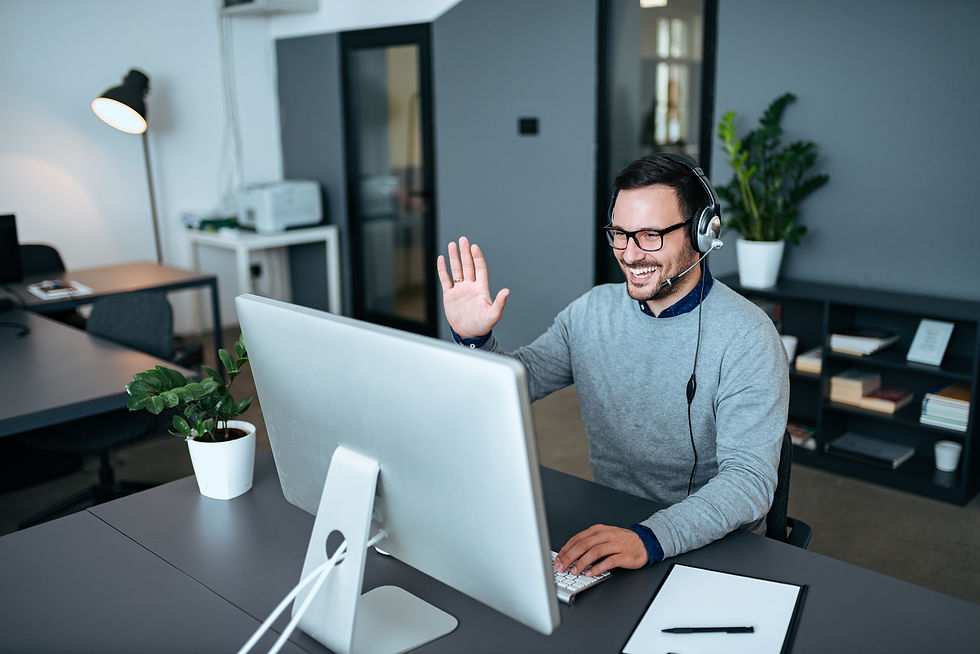The Power of Psychology in Design: Using Principles to Create Effective and Engaging Environments
- amy6872
- Mar 23, 2023
- 4 min read

Designing an office space regardless of if it is in a commercial space or inside a home you need to keep video conferencing in mind, which can add an extra layer of complexity to the process. With the increase of remote work and virtual meetings, video conferencing has become an essential part of many professionals' daily routine. Designing these spaces, one must consider how these design principles can be emphasized to create a space that is optimized for video conferencing calls as well as the typical day to day of the modern-day business world.
Color
When it comes to video conferencing, color can be a double-edged sword. The color scheme of the room can affect how people feel and react during a video conference call. Using calming and neutral colors can help create a sense of professionalism and put participants at ease. Bright or bold colors can be distracting and could interfere with the concentration of participants. Keeping in mind that if you are fair in your coloring or have light colored hair you could become washed out or blend into the background if the colors you have selected are neutral. On the other hand, if you have dark colored hair placing yourself in a room with dark colored walls behind you could result in you blending into the background. It's also essential to ensure that the colors chosen for the room are compatible with you and your overall brand essence you are wanting to convey through the lens.
Lighting
Lighting plays a crucial role in creating an environment that is suitable for video conferencing. A poorly lit room can be unappealing and make it challenging for your audience to see you. Lighting should be positioned correctly to eliminate shadows and reduce glare on eyeglasses, high-gloss surfaces, screens, etc. Natural light can create a more welcoming and inviting atmosphere, but it's also the most inconsistent light source. Bright, harsh lighting can be overwhelming and stressful, while soft, ambient lighting can create a calming and relaxing atmosphere. Lighting can also be used to create visual interest, highlight key elements, and create a sense of depth and dimension. The proper location and the number of light sources is essential to ensure that it doesn't create too much contrast or interfere with your audience’s ability to see you.
Furniture
Furniture is an essential component of a home office or office space, but it's especially important for video conferencing. The furniture should have ergonomic chairs and desks that can contribute to the well-being and comfort, improving overall productivity. The furniture should also reflect the aesthetic of the office, contributing to its overall design and style. But it should also be positioned in a way that maximizes visibility during video calls. A cluttered space can be distracting and negatively impact the quality of the video call and potentially your credibility, professionalism and organization. Trust me, the behind the scenes isn’t always pretty but what our audience sees on video calls should be. With that being said, I need to add that what you see beyond your camera lens is equally as important as what your audience is seeing behind you.
Space Layout
Space layout is an essential aspect of designing any space. It's important to design a space that maximizes visibility and minimizes distractions especially in the case of an office. The layout should be arranged to maximize space, ensure easy navigation, and create an organized and functional environment. The use of room dividers or creating an office space inside a closet can help create a sense of privacy and reduce background noise, improving the call's quality. Designer tip here; furniture does not have to be placed up against the wall. Allow your desk to face the middle of the room and your back faces the wall. Open yourself up to enjoy the beauty of your space and see where the inspiration takes you.
Natural Elements
Incorporating natural elements like plants, water, and light into an office design can have a positive impact on your well-being and mental health by reducing stress, improving air quality, and creating a more calming and relaxing environment. Natural elements can play a crucial role in the psychology of an office space and for your audiences by placing natural elements inside the camera lens of your video calls can add depth, dimension, and visual interest without being distracting.
Textures and Materials
Textures and materials can be used to create a sense of tactility and dimension in an office. Different textures and materials can evoke different emotions and contribute to the overall mood and atmosphere of a space. For example, rough, gritty textures can create a sense of ruggedness and durability, while smooth, polished textures can create a sense of sophistication and elegance.
Conclusion
In conclusion, psychology plays a crucial role in the design of an office environment especially in today’s modern-day business world of video conferencing. By incorporating these principles into the design of your office space, you can create spaces that are not only aesthetically pleasing but also functional and well-suited to meet your needs and those of your audiences as well. Feel free to email me at amy@mudmodular.com if you would like to learn more about how I can help you implement these design principles into your environment.




Comments